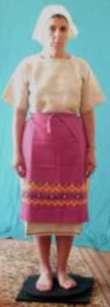In the area of Central Ukraine,
which is the source of most of the information here, there
is a distinction between everyday clothing, which was minimally
adorned, and festive clothing, usually called ukraiins'ke.
Ukraiins'ke means a linen shirt, what we might call a shift,
with heavily embroidered sleeves, embroidery around the
neck, and at the bottom of the shift. Over this is worn
a skirt, usually of colored brocade. The skirt is to be
worn in such a way that the embroidered lower edge of the
shift is visible from under it. An embroidered apron covers
the front of the skirt and a woolen woven belt, usually
called a poias or a kraika is worn on top. Over the shift
and skirt a woman wears a sleeveless jacket called a korsetka
in summer and a long sleeved jacket called a iubka in winter.
Men's ukraiins'ke is primarily an embroidered shirt. The
linen trousers worn by men in the past and the home-made
jackets and coats have mostly been replaced by factory-made
slacks and jackets.
The shift or sorochka can
be made of linen, cotton, or hemp. In the past, hemp was
used for everyday wear since it is a courser fabric of a
darker color. Everyday wear was ideally embroidered at least
around the edges to protect the wearer. It was possible
to omit embroidery altogether. The shift shown here was
donated by Tetiana Oksentivna Levchenko of Korolivka in
the Makariv region of the Kyiv province. It belonged to
her mother who grew the hemp, soaked it and carded it. She
spun the fiber, wove the cloth and then sewed the garment.
Another example of an everyday garment is the summer dress
donated by Polina Iakivna Latysh of Iavorivka, Drabiv region
of the Cherkasy province. It is modeled here by Natalie
Kononenko.

